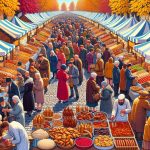
The history of Eastern Europe is deeply marked by the relationship between Jewish and Polish cultures. This relationship has seen a lot of ups and downs over the centuries, including strong communities being built, the tragedy of the Holocaust, and the challenge of rebuilding after the war. Today, we’re seeing a revival of sorts, which raises interesting questions about how these two cultures will continue to interact and influence each other.
Jewish and Polish people have lived side by side for a long time, working together and influencing each other’s ways of life. However, they’ve also faced their fair share of challenges and conflicts. Despite these hardships, both communities have shown a lot of resilience, managing to preserve their identities and even flourish in modern times.
Looking at their journey, it’s fascinating to think about what the future holds for Jewish-Polish relations. How will their shared history and experiences shape their interactions moving forward? And what could this mean for society as a whole, in terms of understanding and coming together? It’s definitely something worth thinking about as we move forward.
Historical Overview
The history of Jewish and Polish communities is deeply intertwined, spanning several centuries characterized by both cooperation and strife. This relationship began in the Middle Ages when Polish rulers invited Jewish settlers to Poland, offering them a place where they could live with a degree of tolerance not found elsewhere at the time. As a result, Poland became a hub for one of the world’s most significant and dynamic Jewish populations.
However, this cohabitation was not without its difficulties. Economic rivalry, religious disagreements, and political turmoil at times fueled tensions, leading to instances of antisemitism. Despite these challenges, there were also periods of peaceful coexistence and mutual cultural enrichment, which played a significant role in shaping the region’s cultural and social landscape.
For example, the Jewish community contributed significantly to Poland’s economic, cultural, and intellectual life. Jewish merchants and craftsmen played a vital role in the economy, while Jewish scholars and artists made lasting contributions to Polish culture. Similarly, the Polish environment influenced Jewish residents, leading to the development of unique traditions and cultural expressions.
This complex history of the Jewish and Polish communities showcases a dynamic relationship influenced by various factors. Understanding this history is crucial for appreciating the rich cultural tapestry of the region and the lessons it offers on coexistence and mutual respect.
Cultural Contributions
The collaboration between Jewish and Polish communities has significantly shaped both cultures, leading to a rich blend of traditions, especially in the culinary world. This fusion brought forth a unique cuisine that marries Polish ingredients with Jewish dietary laws, resulting in dishes that continue to be cherished. For instance, the well-loved bagel, originally from Poland, has become a staple in many parts of the world, showcasing this culinary synergy.
In the realm of literature and philosophy, Jewish authors and philosophers who wrote in Polish played a crucial role in the country’s intellectual life. Their works, deeply rooted in their cultural heritage, added depth and diversity to Poland’s literary and philosophical discussions. One notable figure is Isaac Bashevis Singer, a Nobel Prize laureate, whose stories, though written in Yiddish, were widely read in Polish translation, enriching Poland’s literary scene with his unique perspective.
Music and theater also saw significant contributions from the Jewish community. Klezmer music, with its roots in Jewish tradition, integrated Polish folk tunes, creating a vibrant musical genre that resonates with audiences even today. In theater, Jewish playwrights and actors brought fresh narratives and perspectives, enriching the Polish stage. A famous example is the Ester Rachel Kaminska State Jewish Theater in Warsaw, which continues to celebrate Jewish culture through its productions.
These cultural exchanges between Jewish and Polish communities have not only enriched Poland’s cultural landscape but also underscored the importance of diversity and dialogue in fostering creativity and understanding. By exploring these contributions, we appreciate the complexities of cultural identity and the unifying power of art and tradition. This shared history, with its blend of flavors, stories, and melodies, is a testament to the enduring bond between these two communities, offering valuable lessons on coexistence and mutual respect.
The Holocaust Impact
The Holocaust stands as a dark chapter in history, deeply affecting Jewish-Polish relations. Before World War II, Jews and Poles shared a rich cultural tapestry, with centuries of coexistence. However, the Holocaust not only led to the tragic loss of millions of lives but also broke these longstanding cultural bonds, causing significant damage to their collective heritage.
During this time, the Nazis aimed to eliminate the Jewish population, resulting in the loss of countless lives and the destruction of cultural landmarks. This period also saw a halt in the vibrant exchange of ideas and art that had flourished between Jewish and Polish communities. The impact was profound, leaving a gap in Poland’s cultural and societal landscape that was hard to fill.
The aftermath of the Holocaust has left lasting scars on both communities, altering their identities and the way they relate to each other. To understand this era, it’s essential to recognize the immense loss and the tangled history that complicates Jewish-Polish relations. Despite these challenges, there’s a story of resilience and the ability of cultural identities to adapt and survive under the most harrowing conditions.
This history teaches us about the importance of remembering and learning from the past. Museums, memorials, and educational programs play a crucial role in keeping the memory alive, promoting understanding and preventing such atrocities in the future. For example, the POLIN Museum of the History of Polish Jews in Warsaw offers an in-depth look into the rich Jewish-Polish history before, during, and after the Holocaust, fostering dialogue and healing.
In discussing the Holocaust’s impact on Jewish-Polish relations, it’s clear that this tragic event reshaped the course of history. However, by acknowledging the past and working towards mutual understanding, there’s hope for healing and building a future where such tragedies are never repeated.
Post-War Developments
After World War II, Poland had to rebuild itself from the ashes, including its Jewish and Polish communities. The Holocaust had drastically reduced the Jewish population through unthinkable horrors and forced emigration. Those who survived faced the enormous challenge of piecing their lives back together in a country that was also trying to rebuild and find its new identity.
During this time, there was an effort to bring back Jewish cultural and religious life. However, this was not easy under a communist government that often viewed religious and cultural diversity with suspicion or outright hostility. Despite these challenges, there were determined efforts to reclaim and celebrate Jewish identity.
This period in history is a testament to the resilience of the human spirit. It highlights how, despite great adversity, the Jewish and Polish communities worked towards understanding and living together in a changed world.
For example, despite the government’s stance, Jewish festivals and cultural events started to make a comeback, slowly re-introducing the rich heritage of Jewish Poland. Additionally, educational efforts helped bridge the gap between Jewish and non-Jewish Poles, fostering a better understanding and mutual respect.
This era teaches us the importance of perseverance and the power of community in facing the aftermath of tragedy. It’s a reminder that, even in the darkest times, there’s hope for rebuilding and renewal.
Modern Revivals and Challenges
In recent times, we’ve seen a remarkable resurgence of interest in the shared history between Jewish and Polish communities. This revival isn’t just about looking back; it’s a vibrant, living thing. Jewish festivals are popping back up, bringing music and storytelling that had nearly been forgotten. Synagogues, once left in disrepair, are being fixed up and opened to the public again. And among Poles, there’s a growing curiosity to learn more about Jewish history and the role it plays in their own heritage.
But, as with any attempt to bridge a complex past, there are hurdles. Antisemitism hasn’t vanished, and it rears its ugly head more often than anyone would like. There are also heated debates over how certain historical events are interpreted or remembered. These issues are not just minor bumps in the road; they’re significant obstacles that remind us of the delicate process of healing and understanding.
The efforts to bring Jewish and Polish cultures closer involve more than just celebrations and renovations. They’re part of a broader conversation about identity and memory. For example, when a synagogue is restored, it’s not just about fixing a building—it’s about reclaiming a piece of history that belongs to both Jews and Poles. This kind of work requires a careful balance, acknowledging the pain of the past while also celebrating the shared aspects of our histories.
Despite the challenges, the dialogue between Jewish and Polish communities offers a glimmer of hope. It’s a testament to the power of cultural exchange and mutual respect. By exploring our shared history, we’re not just learning about each other; we’re building a foundation for a more inclusive and understanding future.
It’s important to keep this conversation going, to continue learning from each other, and to face the challenges together. Whether it’s through attending a festival, visiting a restored synagogue, or simply engaging in discussions about our shared history, every step brings us closer to a deeper mutual understanding.
Conclusion
The relationship between Jewish and Polish cultures is both rich and complicated, shaped by hundreds of years of history. They’ve shared moments of cooperation and faced periods of conflict. Despite the terrible events of the Holocaust, these communities have contributed to each other’s cultural wealth.
Nowadays, there’s a push to mend old wounds and celebrate the common ground between them. This journey hasn’t been easy, but there’s hope for a future where they can understand and respect their shared stories better. To keep this positive momentum, it’s important to keep talking, show respect for each other, and take a deep dive into their connected pasts.






Comments are closed.